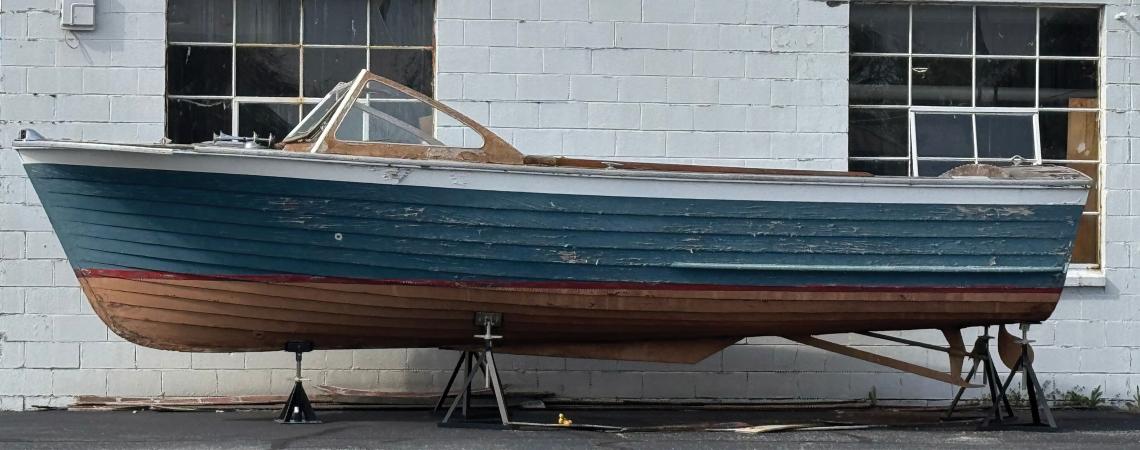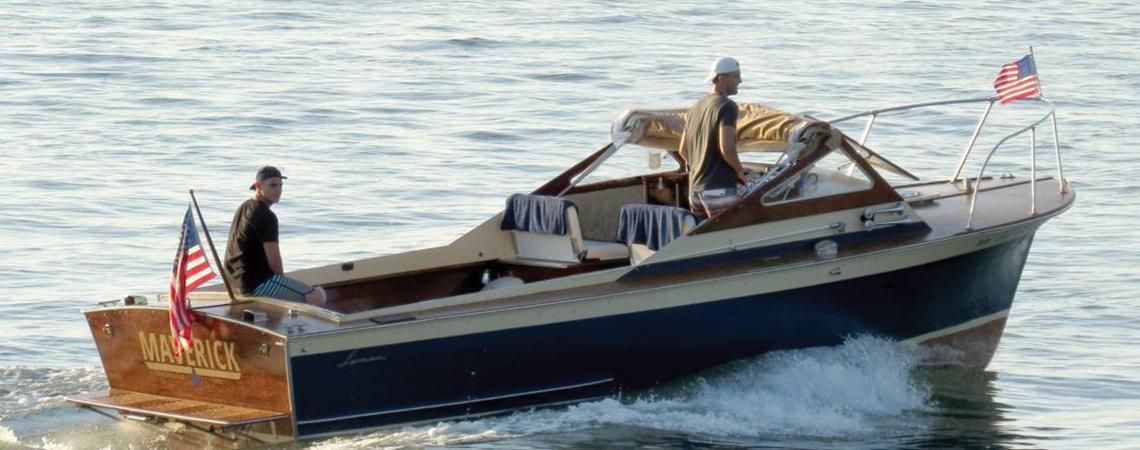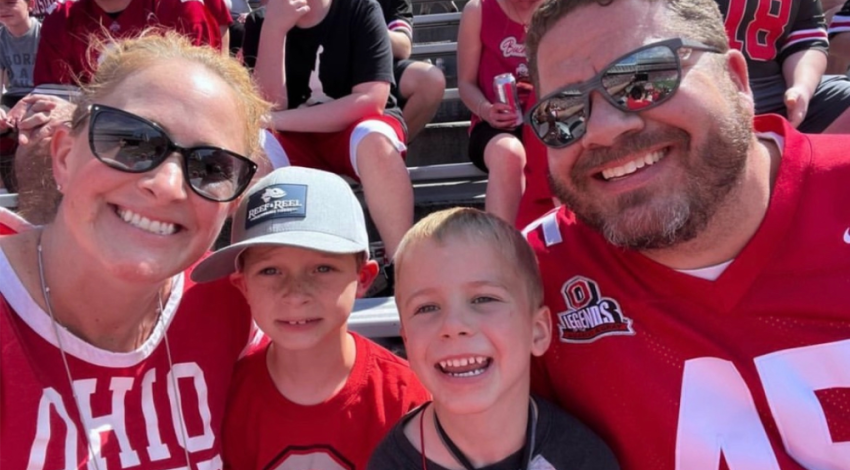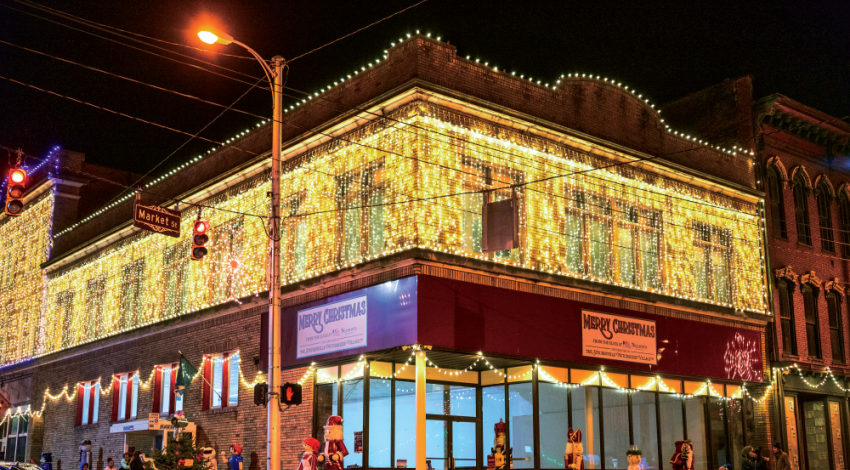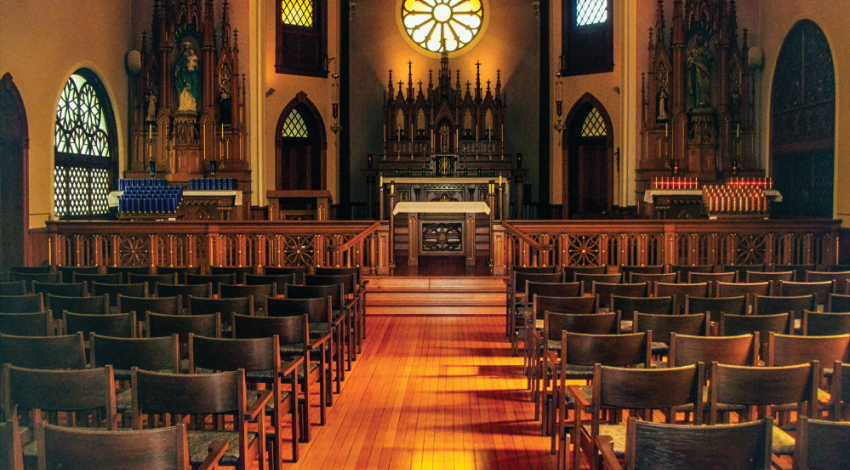The colors of the hull can vary — white, yellow, blue, turquoise — but just about anyone on Lake Erie knows the classic Lyman lines: a deep bow with lapstrake wood, a certain wave-busting flare, the captain’s easygoing air of pride.
The original Lyman Boat Works in Cleveland was founded in 1875, relocating in 1928 to Sandusky, where most of its fleet of more than 60,000 vessels was produced. The company stopped making wooden boats in 1973, though it continued with fiberglass until the early 1980s, when it capsized in bankruptcy.
After all that time, thousands of wooden Lymans still ply the waters — most of them on Lake Erie — and they have a fierce following.
Nate Sublett with one of his freshly minted modern Lyman boats.
Perhaps the fiercest is Tom Korokney, a.k.a. “Doc Lyman.” He purchased the tooling, jigs, fixtures, and archived records from then-defunct Lyman during bankruptcy and moved it all to Lexington in Richland County.
“I’ve used the tooling to duplicate parts through the years,” he says. “And the documentation — I’ve got all the original hull records.” Those records, Korokney says, are sought after by folks who desire historical papers, including certificates of authenticity, for their boats.
And while he’s backed off restoration and repair work these days, Doc Lyman, 73, is still the boats’ No. 1 cheerleader. He spent four years writing Lyman Boats: Legend of the Lakes, published in 2004. He also hosts a Lyman podcast, founded the Lyman Boat Owners Association, and currently is working to establish a Lyman museum in Sandusky.
“There’s a lot of Lyman boats that have been in families for years,” he says. “Especially the smaller ones. They tend to survive because a lot of times they’re just weekend boats, so people take them home and they go in the garage. There’s a lot of second- and third-generation outboards that have been out there for years.”
That’s not lost on Kenny Kreutzfeld, of K&M Restorations in Marblehead, who says folks come to him with an old Lyman that may have been their parents’ or grandparents’ and they’d like to see it back on the water.
He points to one Lyman in his shop, surrounded by vintage equipment such as a band saw from the late 1800s, a Bridgeport drill press from 1938, and a power hammer dating from World War II: “This one here, it’s been in the family since it was new or almost new,” he explains. “That’s pretty common.”
Kreutzfeld says boats like the 26-foot Lyman he’s currently working on (named The Five Pecks) are the most in demand.
“It’s definitely what everyone wants nowadays,” he says as he carefully glues together two pieces of white oak. “It’s a pretty good boat for just about everything. They do real well in Lake Erie, especially since they got the weight distribution just right, a deep-V hull up front — zips through the water just right. Fifteen to 20 miles per hour and you can cut through just about anything.”
“We’re trying to preserve the legacy with a museum here in the near future,” Korokney says. “And the most important thing: We’re going to continue to keep these classic works of art floating.”
New life for a classic design
You don’t have to buy a vintage boat these days to get on the water in true Lyman style. Thanks to Tom Korokney’s saving everything he did from the Lyman factory and a Seville company’s COVID-fueled need to keep employees busy, new Lymans are being built for the first time since the original company went under more than 40 years ago.
Adam Sublett operates Benchmark Craftsmen in Seville, which has designed, fabricated, and managed displays for trade shows, museums, and other customers since its founding 50 years ago by Adam’s father, Nate. But when COVID struck, operations came to a standstill.
“I knew if these craftsmen were let go or laid off, I wouldn’t get them back,” Nate says of his employees. “So we got busy.” Adam and Nate came up with the idea to relaunch Lyman, and Chippewa Boatworks was born.
They got in touch with Kurt Cerny, a marine architect and yacht designer in Annapolis, Maryland. Cerny grew up spending time between North Olmstead and Marblehead, where he remembers listening to his father and uncles debate the merits of their boats. He says all of those conversations inevitably ended with something along the lines of “But nothing handles these waters like that old Lyman we had.”
So they traveled as a group to make their pitch to Korokney.
“We went to see Tom and those crazy archives he hauled out of the Lyman factory,” Nate says. “We went through
drawing after drawing after drawing and picked one we wanted to pattern our work after. Curt went back to Annapolis and came up with a design, and we went for it.”
Nate says the process was not without challenges. While many of the Benchmark employees were boaters, none had actually built a boat before.
But they figured it out. Now, Chippewa produces three handmade models, all based on a 1957 Lyman Runabout, 16.5 feet in length. But these are definitely not your grandparents’ Lymans.
“They’re all-wood hulls, mahogany with lapstrake construction,” Nate says, standing in front of one of three new Lymans at the Catawba Island Boat Show recently. “But every piece of wood is fully epoxy-coated and soaked. All the finishes are modern, so there’s no sanding and varnishing to keep up with like you had to do with the old Lymans.”
Also, there are no dials or gauges at the helm — just a digital screen that communicates directly with the boat’s engines (which can also wirelessly send readings and other info to a phone or other device). “It’s as modern as it gets,” he says.
Nate says there are a handful of companies making new wooden boats these days — but there’s only one Lyman. “Old or new,” he says, “any Lyman on the water definitely gets attention.”


